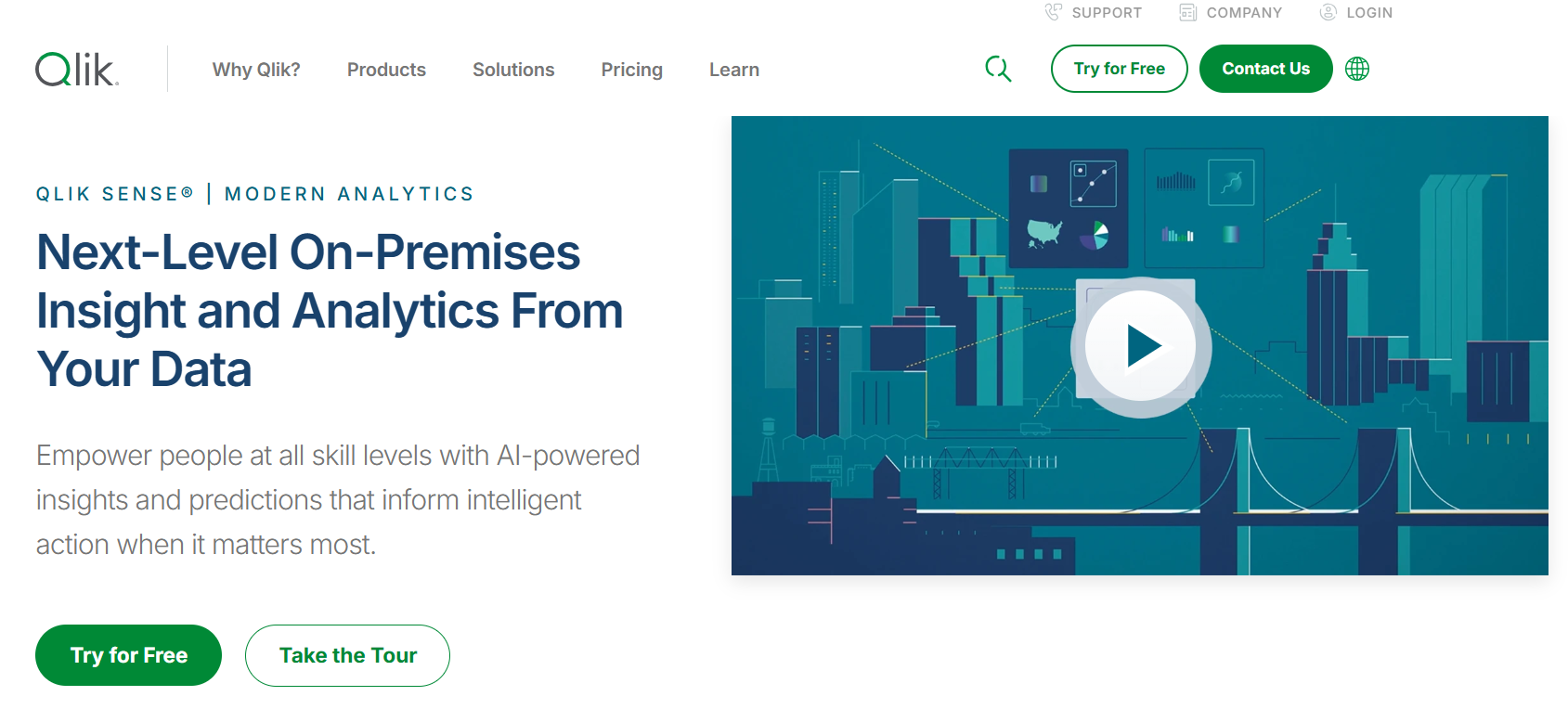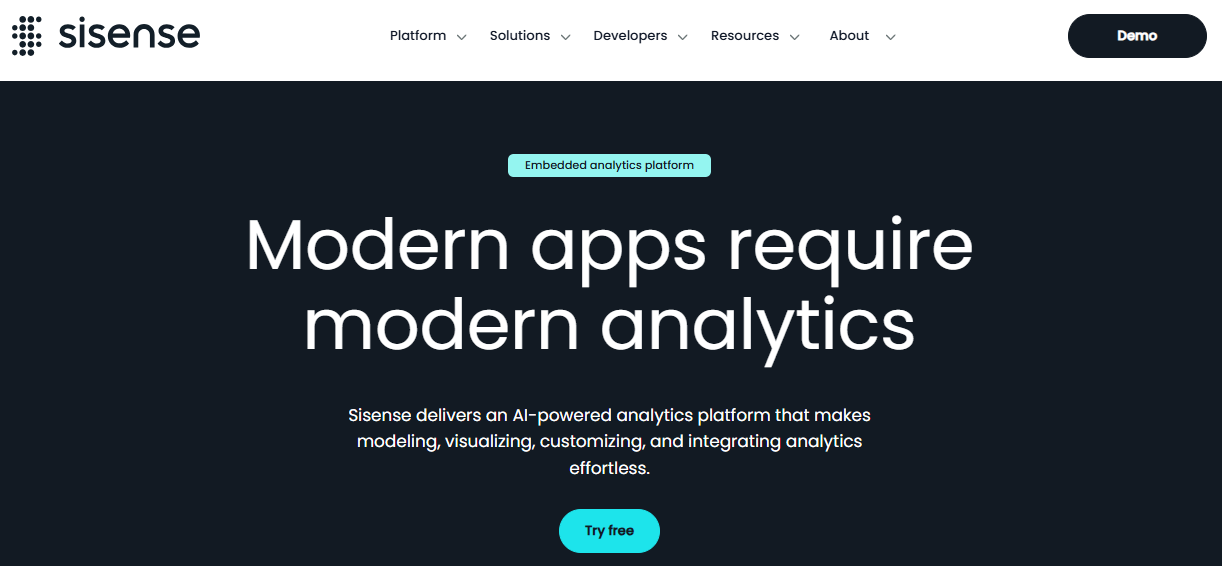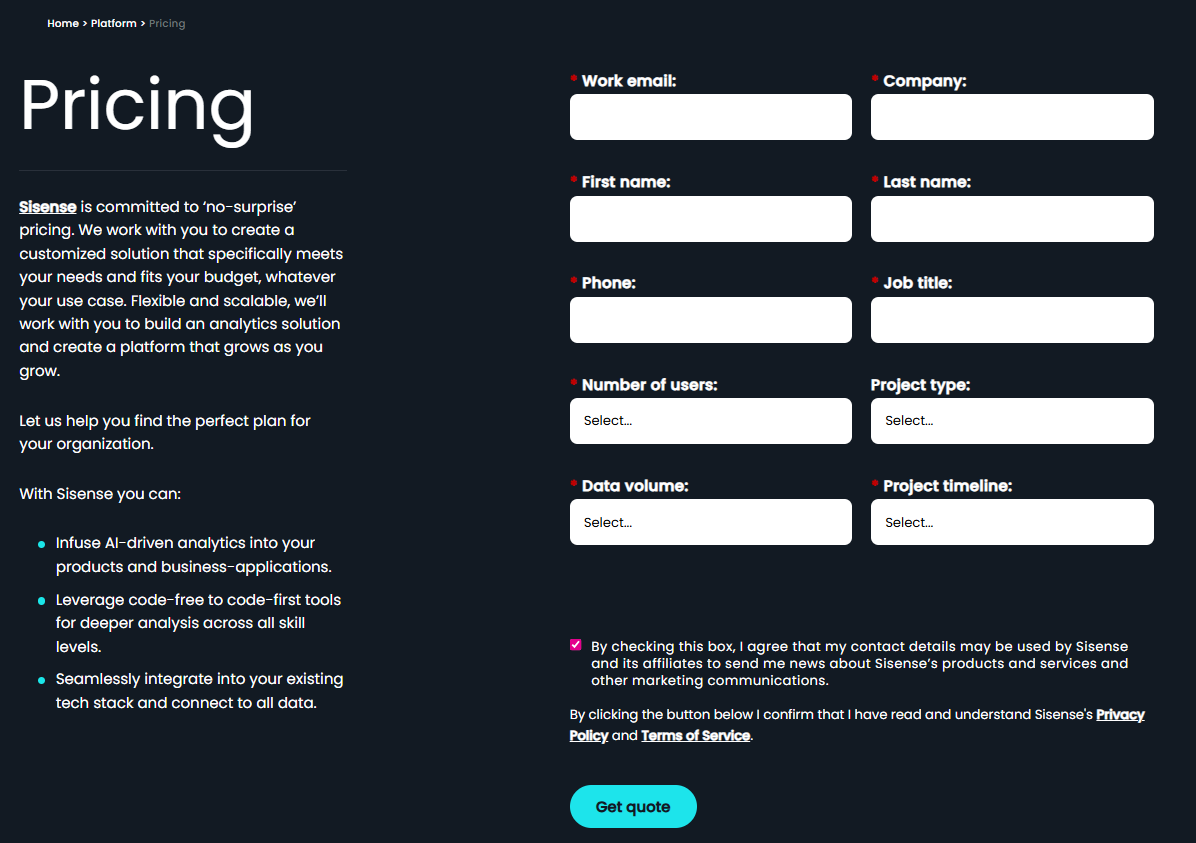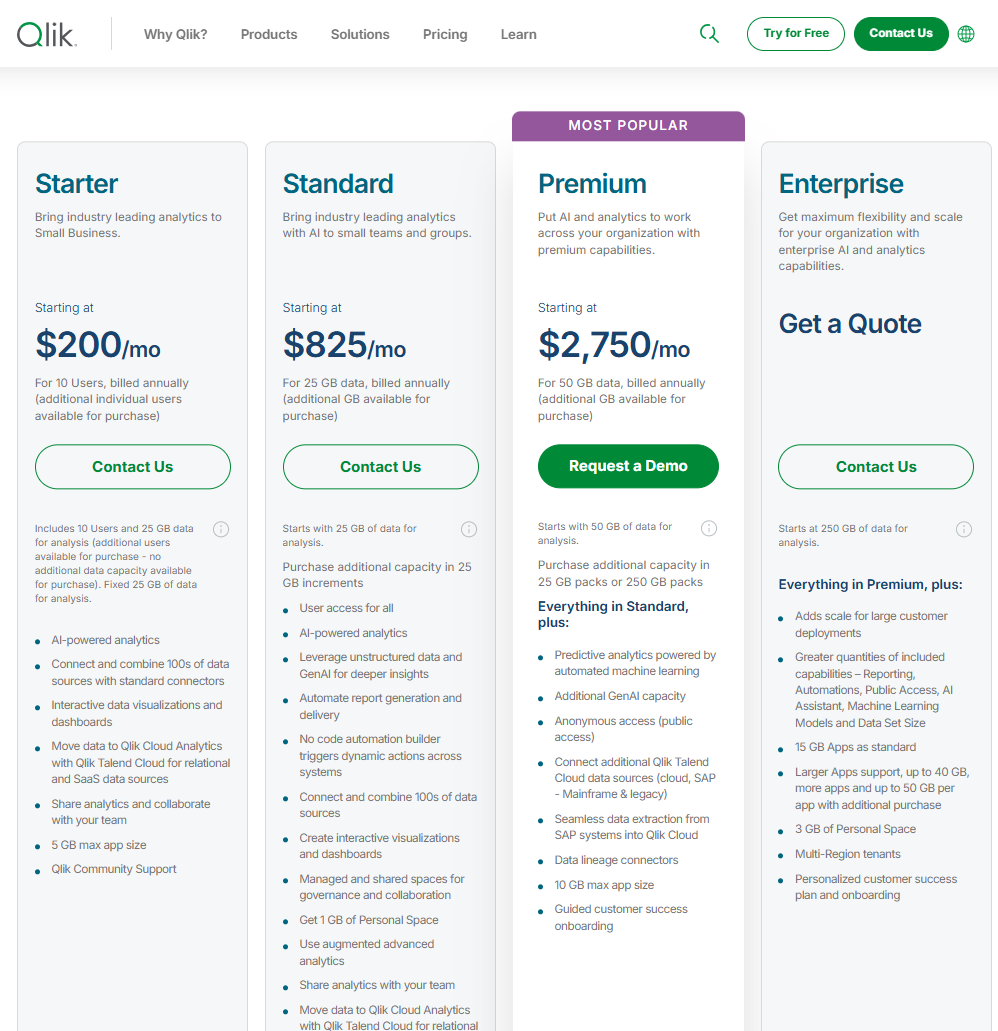Build your first embedded data product now. Talk to our product experts for a guided demo or get your hands dirty with a free 10-day trial.
Looking for a modern business‑intelligence (BI) tool with great ease of use, strong visualization capabilities, a wide range of data connectors and predictable pricing?
This updated comparison looks at Sisense and Qlik Sense in 2026.
We highlight their key features, pros and cons, data integration options and pricing to help you make an educated decision.
Qlik Sense still offers one of the broadest sets of connectors on the market. Out of the box, Qlik Cloud can connect to more than 160 services and databases, including data warehouses (Databricks, Snowflake, Google BigQuery, MongoDB), CRMs (Salesforce, HubSpot, Microsoft Dynamics) and communication tools (Slack, Teams, SurveyMonkey). You can build custom integrations via Qlik’s API and scripting, but you will need developers to design data models and join tables. During 2025 Qlik released several usability improvements: a new sheet‑editing experience exposes tables and fields directly in the edit view and simplifies filter configuration, while new straight and pivot tables, shape labels and custom CSS styling give users more control over the look and feel.

Sisense keeps pace on connectivity. The platform offers connectors for major databases (Redshift, ClickHouse, BigQuery, MongoDB), file stores (Dropbox, Excel, Google Drive/Sheets) and SaaS applications (Airtable, Freshdesk, GitHub, HubSpot etc.). In early 2025 it introduced a centralized connection manager so teams can set up and share data connections from one place. Once your data is loaded, the new Analytical Engine (the default translator since spring 2025) optimises queries and expands SQL support. Directional relationships and a cloud‑native Elasticube Cloud improve performance for large datasets. Overall, Sisense connectors are straightforward to configure: pick a source, provide credentials and import.

Sisense now positions itself as an Analytics Platform‑as‑a‑Service (AnPaaS). In 2025 the company launched Sisense Intelligence, a suite of AI tools that accelerate dashboard creation and insight delivery. It includes an Assistant for building analytics workflows in plain English, Narrative for AI‑generated explanations of charts, and Forecast & Trend functions to surface patterns. Later updates added semantic enrichment that automatically describes tables and fields, a redesigned UI and a design mode for the Compose SDK.
Pros. Thanks to Elasticubes and the new Analytical Engine, Sisense remains fast even with big datasets. Dashboards offer a broad mix of widgets and customization, and the centralized connection manager and co‑authoring features encourage collaboration. A large library of tutorials, community resources and the AI assistant help non‑technical users get started.
Cons. Pricing is opaque and generally high - research suggests self‑hosted deployments start around US $10,000 per year and cloud versions often exceed US $20,000. Sisense has a steep learning curve; advanced analytics and embedded use cases still require developers. The Compose SDK provides code‑first control but is complex, and some new AI features are available only in the cloud. On‑premise customers must plan for eventual migration as Sisense invests heavily in cloud services.
Qlik Sense has evolved considerably since 2024. The platform uses AI and machine learning to help users build dashboards quickly and extract insights. Its associative engine still allows data exploration without predefined queries; you can filter and explore relationships ad hoc across multiple tables. In 2025 Qlik introduced several AI‑driven services:
Qlik Answers - a generative‑AI assistant that lets users ask questions in natural language and receive personalized answers. It indexes your documents and knowledge bases via retrieval‑augmented generation.
Qlik Predict - a no‑code predictive‑modeling service that delivers explainable forecasts and integrates them into decision workflows.
Qlik Automate - automation tools that trigger actions based on data.
Pros. Qlik remains easy to use for basic BI tasks; it offers a wide range of visualizations and improved dashboards. The 2025 updates introduced a smoother sheet‑editing experience, new table widgets and customizable styles. The associative engine handles complex data without forcing a rigid schema. With Qlik Answers and Predict, Qlik Cloud now provides conversational and predictive AI, enabling natural‑language queries and real‑time forecasts. Performance is strong, and dashboards load quickly even with large datasets. Integration with Talend’s data‑integration tools enhances data management and governance.
Cons. Advanced analytics still require expertise; Qlik’s scripting and data‑modeling tools have a learning curve. Users remain dependent on Qlik’s ecosystem of connectors and workflows, which may limit flexibility. Some AI features (such as Qlik Answers and Predict) are only available in Qlik Cloud and may require separate licensing. Pricing is high: the base Qlik Sense package lists at roughly US $2,700 per month, and embedded analytics deployments typically cost about US $90,000 per year. Predictive and AI capabilities may entail additional costs and training.
Sisense doesn't share the pricing publicly. Based on available information, it generally starts around US $10k per year for self‑hosted deployments and around US $20k per year for cloud versions.

Qlik now offers transparent pricing for Qlik Cloud Analytics, starting at $200/month for the Starter plan, $825/month for Standard, and $2,750/month for the Premium plan, which includes predictive analytics and 50 GB of data capacity. Enterprise plans offer large-scale analytics and AI capabilities with custom pricing. Qlik’s AI products, Qlik Answers (generative AI assistant) and Qlik Predict (predictive modeling), are priced separately and require contacting sales. Qlik Talend Cloud data-integration plans are also sales-led. Overall, Qlik is more transparent than Sisense, but full AI/ML pricing still requires engaging with their sales team.


Your end users need data visualizations that look good on any device, display key metrics in real time and integrate seamlessly into your SaaS app. You also need a platform with robust connectors and flexible embedding options that doesn’t take months to implement. Luzmo is a strong alternative for SaaS teams looking for embedded analytics, especially after the company’s recent AI‑driven updates.

Luzmo IQ adds conversational analytics to your product. Users can ask questions in natural language and receive concise answers backed by charts. It includes an embeddable chat widget, AI‑generated executive summaries and search features that return direct answers to queries. A Workflows API connects Luzmo IQ to tools like Slack, and rapid integration with automatic vector embeddings makes setup straightforward. Built‑in query processing and access‑control layers ensure answers are accurate and secure
Luzmo Studio offers a drag‑and‑drop dashboard builder for embedded analytics. You can create responsive dashboards with more than 40 chart types, drill‑downs, filtering and real‑time updates. Studio supports multi‑language, multi‑timezone and multi‑currency experiences, white‑labelled themes and CSS injection. Dashboards embed via iframes or web components and integrate with React, Vue or Angular. Studio focuses on self‑service analytics, giving end users the ability to explore data without leaving your app.
For developers who need deeper control, Luzmo Flex provides a code‑first SDK for building custom analytics. You can programmatically create charts and dashboards, combine them with your own UI components and build report builders or AI‑powered chart generators. Flex automates data queries and security behind the scenes while giving you the option to switch between low‑code widgets and full code control.
Luzmo’s Agentic APIs are modular AI functions for querying, transforming and visualizing data. Endpoints help you describe datasets and columns, perform semantic search, generate formulas and visuals and build chat‑style assistants. You can chain agents (for example, find relevant data then create a visualization) or integrate them with automation platforms. The /iqmessage endpoint supports multi‑turn conversations for custom chat interfaces. Recent updates have improved performance and automated vector embeddings, with predictive capabilities on the roadmap.
Luzmo’s combination of Studio, Flex, IQ and Agentic APIs gives SaaS teams a unified analytics platform with both low‑code and code‑first options. It supports robust data connectors, handles complex data models and scales across tenants. Pricing is transparent, and the roadmap emphasizes modular, AI‑driven analytics. For many software products, Luzmo delivers actionable insights faster than Sisense or Qlik and offers more flexibility for embedding analytics.
Want to learn more? Book a free demo of Luzmo and see how it compares to Sisense and Qlik for your specific use case.
Sisense positions itself as an Analytics Platform-as-a-Service (AnPaaS) with strong embedded analytics, AI assistance and Elasticube performance. Qlik Sense, on the other hand, focuses on its associative engine, strong data preparation, and new AI features like Qlik Answers and Qlik Predict. If you want flexibility in embedded use cases, Sisense offers more options. If you want powerful self-service analytics and scalable data analysis, Qlik leads.
Both tools excel, but in different ways:
Qlik Sense supports 160+ native connectors for warehouses, CRMs, and communication platforms and offers customizable APIs for advanced data integration and analytics.
Sisense provides strong built-in connectors for major databases, SaaS tools, and files, plus a centralized connection manager that simplifies governance.
If your priority is broad connector coverage, Qlik wins. If you want easier setup and maintenance, Sisense Fusion (the core of the platform) is more user-friendly.
Pros
Cons
Pros
Cons
Sisense: Self-hosted: ~ $10k/year, Cloud: ~ $20k+/year
Qlik Sense: Starts around $2,700/month, Enterprise or embedded: ~$90k/year
Both tools require a sales quote. Neither is budget-friendly for small SaaS businesses.
Qlik Sense leads here thanks to Qlik Predict, a no-code, explainable forecasting engine integrated directly into workflows. Sisense offers Forecast & Trend functions, but these are narrower in scope. If predictive insights matter, Qlik is the stronger choice.
Yes. Sisense Fusion continues to power the architecture behind Sisense’s AI, Elasticube Cloud, and embedded analytics. It enables:
Fusion is one of the biggest reasons SaaS teams choose Sisense.
For self-service BI, Qlik has the edge due to its associative engine and improved sheet editing.
However, Sisense’s AI Assistant and Narrative make dashboard creation more accessible for business users.
Ease-of-use score:
Qlik: Best for exploring and modeling data
Sisense: Best for automated explanations and guided workflows
Across major review sites:
Sisense users praise customization and performance but note complexity and pricing concerns.
Qlik users love the associative model and visualizations but mention a learning curve and costly licensing.
Bottom line: both score highly, but neither is ideal for beginners seeking a lightweight BI tool.
Sisense stands out with:
If your app needs tightly integrated embedded analytics, Sisense offers more flexibility.
Qlik provides:
If your team needs advanced modeling, Qlik is the better BI platform.
Yes, Luzmo is a modern embedded-analytics platform that many SaaS teams prefer over Sisense or Qlik because it’s:
It also includes:
For companies wanting fast, actionable insights inside their product, Luzmo is a compelling choice.
Build your first embedded data product now. Talk to our product experts for a guided demo or get your hands dirty with a free 10-day trial.
